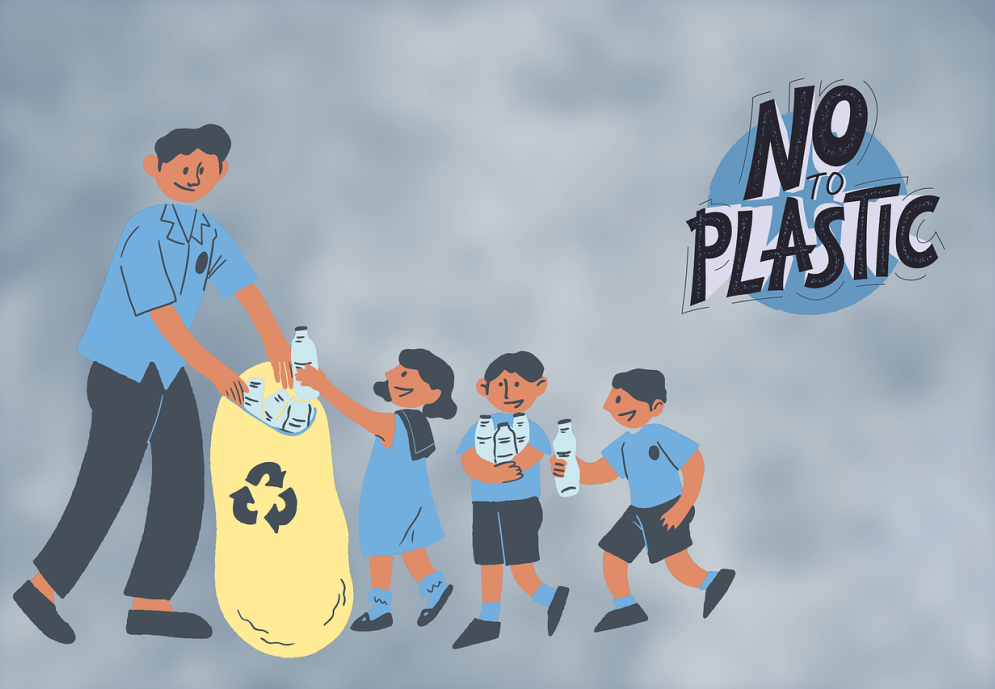

Plastic in school (medium level)
Discussion and experiments on microplastics for older pupils, with video link and classroom activities.
Lernergebnisse
The pupils…
- know the sources and pathways of plastic and microplastics
- carry out experiments to detect and quantify microplastics
- carry out scientific experiments to record waste, determine results and evaluate them
Zeitaufwand
4-6 teaching units
Werkzeuge, Materialien oder Ausstattung
Unit 1:
- Various objects made of plastic (e.g. plastic bottle, packaging material, plastic bag, toy/everyday object made of plastic, coated paper cup, clothing made of polyester)
- Technical equipment for playing a video
Unit 2:
- Tea filter
- Spatula
- Pipettes
- Petri dish
- Hair dryer
- Binoculars (or magnifying glass)
- Cosmetic products (brought by students)
- Tap water
Unit 3:
- Measuring tape
- Writing materials (e.g. clipboard)
- Measuring protocol and pen
- Marking rods
- Cones for marking
- Bucket
- Gloves
- Clothing suitable for the weather
Beschreibung der Aktivität
Unit 1
1. The teacher presents various plastic objects to the class.
Look at the different objects. Clarify in class discussion what they all have in common.
Now work together with a partner. Gather your prior knowledge on the topic of plastic by creating a fact sheet with the following categories:
-
- Chemical name
- Origin
- Properties
- Use of plastic
- Significance in technology
- Meaning in nature
Compare your results in class and complete your profile if necessary.
2. The teacher shows the video on the topic of plastic:
Watch the video on the plastic problem carefully. Take notes on the following questions:
- What happens to our plastic?
- What is the danger of plastic in the environment?
- Why is plastic still being produced?
Discuss your findings from the video in class. On the board, compare the problems of plastic and the challenges of reducing plastic waste.
3. Homework:
Microplastics and their dangers were mentioned in the video. Formulate a definition for the term and briefly explain the formation and dangers of microplastics.
Bring a cosmetic product of your choice to the next lesson to analyse it for microplastics. (e.g. cream, scrub, facial cleanser, sun cream)
Unit 2:
Analyse the cosmetic products you have brought with you for microplastics. Work in small groups of 3 to 4 students and compare the different cosmetic products within the group.
First read through the complete experiment procedure and have all the necessary materials ready before you start.
After the experiment, think about the following questions:
- What could the residues found be? Look at the ingredients of the cosmetic product. Can you find a name that could conceal microplastics?
- Why are microplastics used in cosmetic products?
- What could be used instead of microplastic particles?
Compare your test results and your thoughts in class. Then discuss ways in which microplastic pollution can be reduced. Collect your thoughts on the board.
Important note!
Avoid the entry of microplastics into the waste water. Dispose of the filters and the extracted microplastic particles in the residual waste.
Unit 3 (Optional)
Preparation:
In the last lesson, you identified microplastics in products and looked at ways to reduce the amount of microplastics entering the environment.
Now you will learn about a method that can be used to determine the pollution of the environment with plastic waste and microplastics. To do this, you will take the whole class to a place that is affected by waste pollution (e.g. beaches, lake/river banks, parks, school playground, etc.).
Before you set off on your plastic search, read the background information and the experiment thoroughly. Clarify questions in class and make sure you pack all the materials you need to carry out the experiment.
Tipps, wie das Thema in den Lehrplan integriert werden kann
Chemistry/science
This teaching material is suitable for use in the subject of chemistry in the area of ‘Substances and substance properties’. However, due to the interdisciplinary aspects (biology), the teaching materials can also be used as part of project days focussing on ‘sustainability’ and ‘natural sciences’.
Optional:
If possible, an excursion to carry out the 2nd experiment is recommended. This provides students with an understanding of scientific work and offers a practical approach to this current research topic.
Tip:
It is advisable to carry out a ‘pre-sampling’ before carrying out experiment 2 in order to record the average amount of waste. The size of the groups and the collection fields can then be adapted to the results.
Extension option:
The teaching unit can be supplemented by participation in the EU-funded ‘Plastic Pirates - Go Europe!’ project. In this project, school groups and extracurricular youth groups help to research environmental pollution near water bodies. They collect data on the occurrence of waste on the banks of rivers and coasts and make this available to the project. Currently, 13 European countries are participating in the initiative, thus raising awareness of the importance of water bodies and the protection of our natural resources. More information about the project at: https://www.plastic-pirates.eu/en
